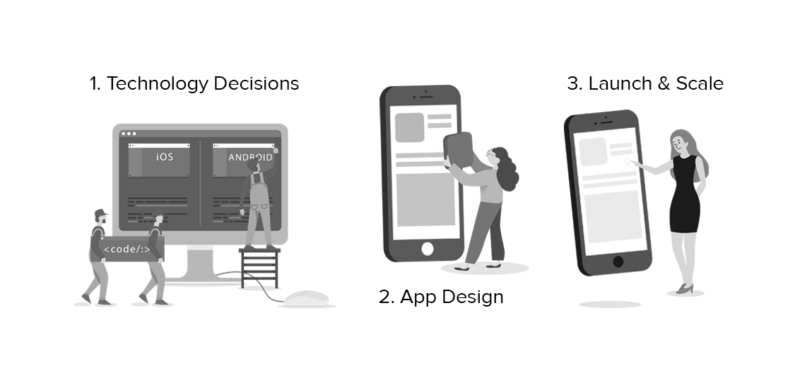
The mobile app startups are gearing up, with investor recognition and a strong customer base. Some of the renowned app startups include Uber, Lyft, Zomato, Whatsapp, Instagram, and Snapchat. Each has been funded by investors, post their show of innovation and an increase in the customer base.
The question remains on how to start a startup?
It all begins with an idea. If you have an outstanding idea, one that will remarkably fit into the user’s needs, then you need to start by building the first ever app. This appears to be smoother in an idea or on paper than in reality. The idea of building a mobile app that will be used by many users and will become popular, is quite an idea; however, making it a reality is quite challenging.
Most startups fail to ask these simple questions:
- What approach should we take to build the mobile app?
- What is the planned timeline to get the mobile app to the market?
- What kind of user interface would attract the attention of the user base?
- What type of technology should we opt for, when developing the mobile app?
If these crucial questions remain unanswered, chances of failing as an appreneur is high. You will not be able to design to the needs and will be short of devising the app solution that your market seeks for.
With the right planning and a mobile app business plan by your side, you can overcome most of the challenges posed in front of you, and win your audience.
#1 Start with the technology decisions
This is the first part of the strategy. A winning idea can be converted into a successful mobile app only when you have a complete idea about the technology aspects of the mobile app? Answer the following questions before you go any further.
Are your customers present on both iOS and Android?
Do you believe you want to establish presence on both platforms at the same time?
Would it be better, if you started with one of the two, and then extended the logic to the other platform, after the success of the previous one?
What kind of performance are you expecting from the mobile app?
Do you think the maintenance and scalability can be potentially handled when you derive the mobile app for both the platforms?
Yes, when you answer all these questions correctly, you will be able to make the technology decision correctly.
Once you are aware of the technology, and the development process, your chances of success go higher.
At this point, you will be able to devise the blueprint for the business startup apps, while considering the platform versions, form factor and the different types of devices in consideration. The main challenge is to design responsive and make sure that the app configures seamlessly on the different devices.
#2 App Design Considerations
The second part of building your startup app is a winning design. At this point, you will need to work with your users, understand their needs, and know how they work. You will need to research on the app usage, their app behaviour and even their thumb zones. The design should perfect the needs of the app user.
For instance, if the app user in your target segment uses a thumb to access the screen, you should design the application for the thumb zones. The buttons and even the menu should be made accessible with the thumb.
The golden rules of top and bottom navigation should be incorporated in your design. The navigation should be built on the learning of the user. For instance, the user is already used to navigation from their previous app usage. You should ideally build on that learning so that it becomes easy for the app user to navigate and use the app.
The design should be usable and user-friendly.
#3 Launch and Scale it Right
You need to strategize for the launch phase right from the development stage. This will work in two parts- how to launch, and how to monetize the app. Make sure you are ready with both the strategies at the mobile app development phase itself.
Launching it too early can lead to no acceptance from the users, and launching it too late would mean too many competitors for you. You will be able to arrive at the right hour with the help of some research and understanding of the competition and their apps.
You should always get the prospects on-board, and seek their opinion on your app. If possible, go for a beta version, and see how they react to the app and its features. If it excites them, then you can go ahead with the full launch, else incorporate their feedback into your app.
The users will be able to tell you what your app is missing out on, and will be able to help you get it into the app.
Don’t scale your app or introduce new features, before you are ready to launch the application. Test the features, see how the user reacts, and then upload the app to the market. Once the response is satisfactory, you can go with the scaling.
Summing up
Launching a mobile app startup is not enough, you need to be constantly working on getting the features right and ensuring your app is updated to meet the evolving requirements posed by the user. Make sure you keep a tab on the reviews posted by the user, to check for feedback. This will help you listen to the voices and incorporate their needs, if feasible. Success occurs when you are in tune with your audience.

